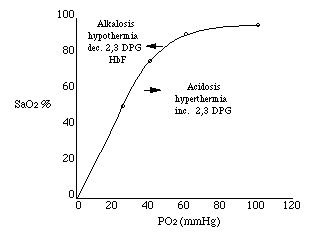Copy link
Peripheral oxygen delivery
Last updated: 03/06/2015
Components of Oxygen in Blood
Oxygen delivery to the periphery depends on the oxygen content of blood and tissue blood flow. The oxygen content of blood has two components: oxygen bound to hemoglobin and oxygen dissolved in plasma. Oxygen bound to hemoglobin is generally the much greater contributor to oxygen content. (One notable exception when oxygen dissolved in plasma is a major contributor is carbon monoxide poisoning: hemoglobin has 230 times greater affinity for carbon monoxide than oxygen.) Tissue blood flow is equal to cardiac output.
For a more complete discussion of this, please see link in “See Also” (right).
Oxygen Delivery
Therefore, oxygen delivery can be calculated:
DO2 = CaO2 x CO
Oxygen Content
Oxygen content can be calculated as: CO2 = (1.39 x Hb x O2Sat/100) + (0.003 x PO2)
Oxygen Consumption
Oxygen consumption can be calculated by the Fick principle as the difference between arterial and venous oxygen content: VO2 = CO x (CaO2 – CvO2)
Oxygen Dissociation
The oxyhemoglobin dissociation curve relates oxygen saturation at varying oxygen tensions. The oxyhemoglobin dissociation curve is S shaped, reflecting subunit cooperativity. Using the dissociation curve and the equations above it is possible to calculate oxygen delivery and consumption.
Under normal conditions, the oxygen tension of arterial blood is 95 mmHg (oxygen tension at the pulmonary capillaries is 104 mmHg, but pulmonary capillary blood then mixes with bronchial blood to reach an arterial oxygen tension of 95 mmHg), and is fully saturated. Using the oxygen content equation and a hemoglobin concentration of 15 g/dL the amount of oxygen this blood caries is 21.14 mL/dL. If cardiac output is 5 L/min, then total oxygen delivery is 1057 mL/min. This blood then travels to the periphery where the PO2 is 40 mmHg. From the oxyhemoglobin dissociation curve, it is evident that a PO2 of 40 is equal to an oxygen saturation of 75%. Using the equation for oxygen content again, the amount of oxygen in venous blood is 15.76 mL/dL. Using the Fick principle, oxygen consumption is calculated as 269 mL/min
The S shape of the oxyhemoglobin dissociation curve allows blood to unload oxygen where it is needed most, thus in the periphery small changes in the partial pressure of O2 lead to large changes in the % saturation.
Shifts in the Dissociation Curve
Shifts of the oxyhemoglobin dissociation curve result from changes in pH, temperature, 2,3-DPG, type of hemoglobin, and also interestingly: some inhaled anesthetics cause a rightward shift.

Copyright Information

This work is licensed under a Creative Commons Attribution-NonCommercial-NoDerivatives 4.0 International License.